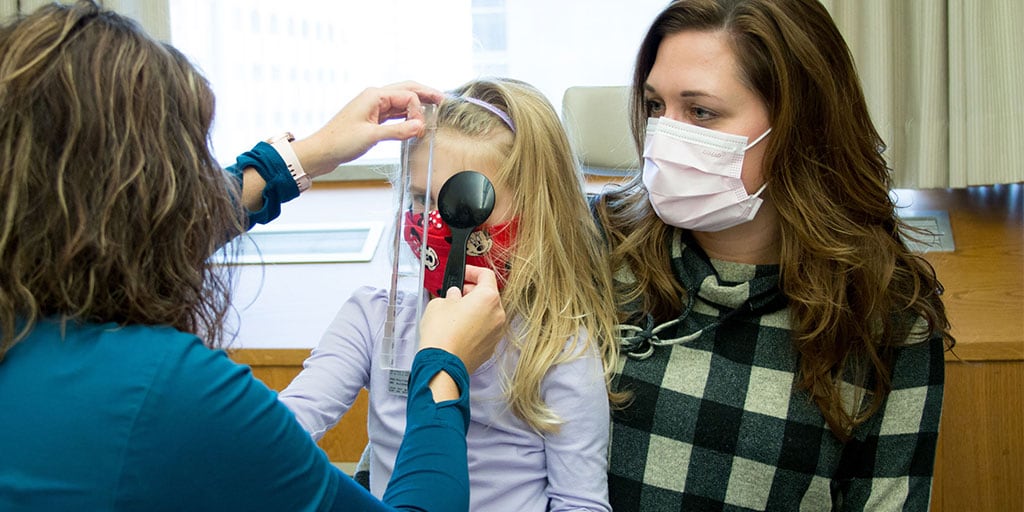
What does an orthoptist do?
An orthoptist is a health care provider within the ophthalmic field. They are an advanced provider and help people who have specific conditions of the eye.
Orthoptists specialize in the evaluation and treatment of eye movement problems and binocular vision. They are uniquely trained to treat disorders such as amblyopia, genetic disorders, and complex pediatric and adult strabismus.
Scope of practice
An orthoptist is specifically trained to evaluate how to eye functions, and interpret test results. They diagnosis eye movement disorders, and work with the ophthalmologist in formulating and managing individual treatment plans. In a typical day, orthoptists:
- Perform patient examinations and tests to evaluate vision and look for eye issues and disorders
- Evaluate, detect, and diagnose amblyopia, diplopia, genetic disorders of the eye, complex pediatric and adult strabismus, and other eye movement conditions
- Create treatment plans for patients with eye movement problems and binocular vision
- Work with ophthalmologists with surgical planning of some eye movement disorders
- Help patients and their family members understand their eye disorders and treatment plans
Orthoptist vs. optometrist
Optometrists diagnose and treat a wide variety of eye and vision disorders, injuries, diseases, and other issues. After obtaining a bachelor’s degree, they must complete a Doctor of Optometry (O.D.) degree (typically four years), and obtain a license to practice.
Orthoptists are more specialized in their work and specifically work with eye movement problems and binocular vision. They are uniquely skilled in diagnostic techniques. After obtaining a bachelor’s degree, orthoptists typically complete a two-year fellowship certification and obtain a license to practice.
Specializations
The orthoptist field is a specialized field in that it directly works with eye movement problems and binocular vision.
Work environment
Most orthoptists work in an exam office setting in hospitals, academic medical institutions, private ophthalmology offices, and a variety of clinical settings. Most work full time, and some work on evenings and weekends to accommodate patients’ needs.
Patient care is a huge part of being an orthoptist. Orthoptists work with patients of all ages, but the large majority of their patients are children, so they need to have a passion for working with pediatric patients and their family members. They also work with ophthalmologists, ophthalmic assistants, nurses, and other members of the health care team.
Becoming an orthoptist
If you have a passion for helping people, an interest in the medical field, and are fascinated with ophthalmology, becoming an orthoptist may be a great career path. High school students can prepare for a career as an orthoptist by taking advanced courses in math, science, and health courses like biology, chemistry, algebra, social sciences, or related courses.
Higher education requirements
There are many pathways to becoming an orthoptist, but typically the pathway involves four to six years in higher education that includes:
- Completion of a bachelor’s degree. Many choose a degree in biology, social sciences, or related field.
- Completion of a two-year fellowship training program from an accredited certification body.
Certification process
After completing a baccalaureate degree and post-graduate program, you must pass the American Orthoptic Council Orthoptists certifying exams, given by the American Association of Certified Orthoptist (AACO) to become a certified orthoptist.
Career opportunities and outlook
The median salary for an orthoptist is typically $100,300 a year. However, this greatly depends on their position, employer, level of expertise, and area of the U.S. or world where they practice.
The orthoptist role is growing. As a newer field, it is gaining in popularity as the demand for health care services also grows.
By the numbers
median annual salary
years of higher education
job growth projected from 2020-2030
Orthoptic programs at Mayo Clinic
Mayo Clinic offers a 24-month Orthoptic Program in Rochester, Minnesota, to prepare students for a career as an orthoptist.
Browse similar careers

Audiologist

Child life specialist
